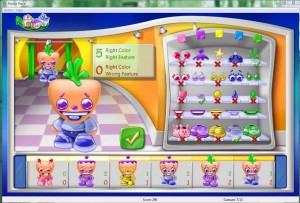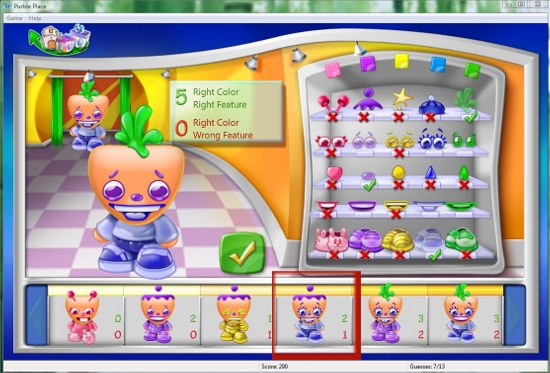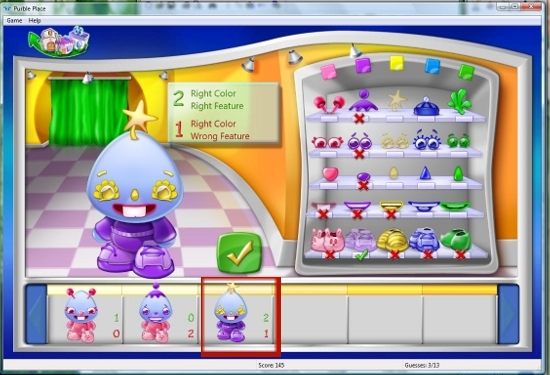 I’ve been playing a deductive reasoning game aimed at children as brain stimulation and to gauge my mental acuity (if my game play goes downhill, I know I’m tired). I’ve played this game several times a day for the past couple months. I’ve discovered that once I recognize a pattern, I find it more difficult to walk through the steps that helped me recognize that pattern. So I’m left with the sense of knowing the right choice without knowing how I know it. I wonder whether this type of thing is part of the reason why it can be difficult to change a certain pattern of thinking. We may have the skills to walk it through step by step in order to recognize an error, but the brain says, “Hey, I recognize this pattern; I’ve already made the call on this so I don’t have to go through those steps anymore.” I’m reminded of Gestalt theory, but maybe there is something more on the nose? Here’s what I wrote in an offline notebook on September 26 about playing the game:
I’ve been playing a deductive reasoning game aimed at children as brain stimulation and to gauge my mental acuity (if my game play goes downhill, I know I’m tired). I’ve played this game several times a day for the past couple months. I’ve discovered that once I recognize a pattern, I find it more difficult to walk through the steps that helped me recognize that pattern. So I’m left with the sense of knowing the right choice without knowing how I know it. I wonder whether this type of thing is part of the reason why it can be difficult to change a certain pattern of thinking. We may have the skills to walk it through step by step in order to recognize an error, but the brain says, “Hey, I recognize this pattern; I’ve already made the call on this so I don’t have to go through those steps anymore.” I’m reminded of Gestalt theory, but maybe there is something more on the nose? Here’s what I wrote in an offline notebook on September 26 about playing the game:
I am having a problem with understanding. “Understanding” may not even be the right word. More and more as I recover cognitive functioning, I find that I can produce a correct answer to a question or provide a correct solution to a puzzle, without easily being able to explain how I arrived at the thing. I’ve been playing this collection of children’s games that are included with Windows Vista, Purple Place. Yes, I play them all, even the cake-making game. One of the games, though, is of a type I especially enjoyed as a kid and still do as an adult. In this game (Purple Shop) there are five features (hat, eyes, nose, mouth and clothes) and five colors (red, purple, yellow, blue, green). Each turn of the game, the player chooses a color for each feature and gets back totals for “right color-right feature” results and “right color-wrong feature” results. So, if the eyes are blue, but the player chooses blue for the nose instead, then blue would be a “right color” but on the “wrong feature” resulting in one (1) “right color-wrong feature” result. Say that in the course of guesses and results, it becomes clear to me that the nose has to be blue. It comes to me and there’s a certainty of belief. I know that the nose has to be blue. Then I stop to explain how I’ve come to that conclusion and there’s confusion where there used to be clarity. Why is my conscious mind fighting me? I’ve played the game slower several times, and that seems to help with the confusion. I can work out the solution step by step, but it’s like chewing nails.
I played these types of games a lot as a kid, so I imagine that I had some pattern recognition early on while playing Purple Shop and that is why working out the solution step by step left me feeling so uncomfortable (mental motion sickness). I don’t remember having the same level of confusion that I do now at explaining my decision making in detail… probably because I wasn’t trying as much to explain all the steps every time as I have been more recently. I think something about the process of regaining cognitive function has made certain things about how I learn more clear to me. Here’s an example of what I’m talking about (Note: I’ve been playing the game at the “advanced level” with five colors and five features in which the player has to X out his/her own impossible options. In less advanced levels, there are fewer choices and the game automatically Xs out impossible options.) :
Each of the panels represent a turn during which I have made selections and gotten the results off to the right in each panel. Looking at the fourth panel outlined in red, there is one “right color — wrong feature” result (the number “1” is in red indicating this result). The Steps: This result has to refer to the purple hat. From a previous panel, I know that at least two of the features are purple, so the purple is definitely a “right color”. If the color blue were on a wrong feature then there would be two “right color-wrong features” and not just one. The only way for the color blue to be a right color, but on a wrong feature would be for the hat to be blue since every other feature is blue already. So, if blue were wrong, the blue would be replacing the purple meaning that the purple would also have been on the wrong feature thus resulting in two(2) “right color–wrong feature” results.
Now, when I see a panel that’s similar to this one, I know that purple (in this case) is the “right color-wrong feature” choice without thinking about it and I also know that that feature cannot be blue. Here’s a similar panel:
This time the focus is on red and yellow. Purple is there, too, but I know from a previous move that the purple is definitely a “right color–right feature” so it’s out of consideration. Looking at red and yellow, I’m presented with the same pattern as above. There is one red colored feature, all the rest are yellow, and there is one (1) “right color–wrong feature” result. So, I know that the mouth cannot be red and it cannot be yellow. Looking one panel over to the second panel, in which the clothes are red and everything else is purple, there is an example of the situation where the clothes have to be purple since there are two(2) “right color–wrong feature” results in contrast to the very first example with only on “right color–wrong feature” result. If purple is on the wrong feature, then the clothes are the only “right feature” left since everything else is already purple.
As I’ve said, in the beginning it was a lot easier for me to slow down the game play and walk through my thinking for every step, but I found that process got harder and harder to do as I recognized more patterns. I wasn’t always recognizing these patterns on a conscious level. I just got the result. My brain seemed to like seeing things in patterns and resisted my conscious mind challenging the pattern recognition. I started to feel physically uncomfortable when I slowed down to ask why I arrived at a certain result.
Looking again at the original picture, by the fourth panel, it’s also clear that the hat has to be green:
Panel 1 — I learn that none of the items are colored red.
Panel 2 — I learn that two of the items are colored purple.
Panel 3 — I learn that none of the items are colored yellow, because the results add up to two and I know that the “two” result has to do with purple since two of the items are purple.
Panel 4 — I learn that the hat can’t be purple and it can’t be blue.
All the four other colors are eliminated, so the hat has to be green. Even when I play the game quickly, I find that I may arrive at the conclusion that the hat has to be green without a conscious awareness of how I got there. Looking slowly over the panels, the answer is clear, but I believe that I sometimes recognize patterns over several moves without being aware of that on a conscious level.
This is all well and fine for a game, but I wonder whether I and others do this for social “truths” as well. If I decide or further still, if I’m instructed at some point that females are less good at math than males, would my brain resist going through the steps to challenge that thought? Might I trust that there is a pattern that shows that males are better at math than females and therefore close off thinking that might show otherwise? And what then for more complicated social “truths”?
Find instructions and links for downloading the Purple Place games here is you don’t have them already.

